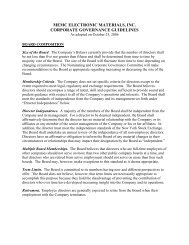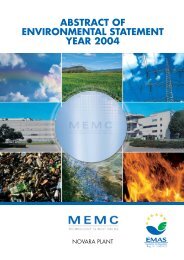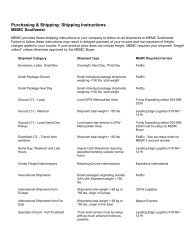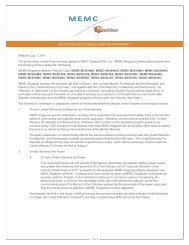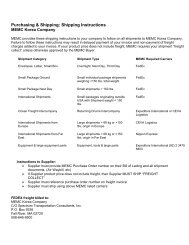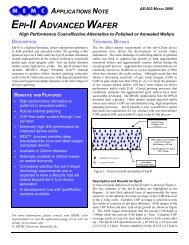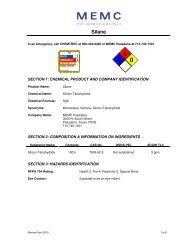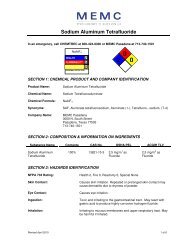BUILDING ON THE PAST, READY FOR THE FUTURE: - MEMC
BUILDING ON THE PAST, READY FOR THE FUTURE: - MEMC
BUILDING ON THE PAST, READY FOR THE FUTURE: - MEMC
You also want an ePaper? Increase the reach of your titles
YUMPU automatically turns print PDFs into web optimized ePapers that Google loves.
28<br />
1970<br />
The SEMI organization<br />
is founded by Bill<br />
Hugle, Fred Kulicke,<br />
and John Dannelly.<br />
1971<br />
Electronic mail<br />
(E-mail) is invented.<br />
1972<br />
The word<br />
processor<br />
is invented.<br />
1973<br />
Three-inch wafers<br />
go into commercial<br />
production at the St.<br />
Peters plant.<br />
1975<br />
Four-inch wafers<br />
go into commercial<br />
production at the St.<br />
Peters plant.<br />
1976<br />
Montedison builds a<br />
second plant in Novara,<br />
Italy. This plant would<br />
later become merged<br />
with <strong>MEMC</strong>.<br />
1979<br />
<strong>MEMC</strong> is the first to<br />
commercially produce<br />
125mm wafers.<br />
<strong>MEMC</strong> builds a plant in<br />
Kuala Lumpur, Malaysia.<br />
The computer floppy disc is<br />
invented.<br />
The microprocessor is<br />
invented. It is considered a<br />
computer on a chip.<br />
<strong>MEMC</strong> opens Kuala Lumpur,<br />
Malaysia, plant.<br />
<strong>MEMC</strong> is the first wafer<br />
supplier to control oxygen.<br />
The inaugural SEMI Awards<br />
are held, with eleven<br />
individuals recognized<br />
for their achievement in<br />
advancing equipment and<br />
materials technology.<br />
applications took hold and the market began<br />
to develop.”<br />
Industry experts agree that device<br />
manufacturers drove the change toward<br />
larger wafers, primarily as a means for<br />
cutting costs. Circuits were printed on<br />
the wafers using photolithography, and,<br />
simply put, the more devices per wafer,<br />
the lower the cost. But they also agree that<br />
the silicon wafer manufacturers, including<br />
<strong>MEMC</strong>, complied with the demands in part<br />
as a means of asserting their technological<br />
capabilities. <strong>MEMC</strong>’s customers in the fastmoving<br />
electronics industry were putting<br />
more and more circuitry on smaller chip<br />
areas. To do that, they needed smaller line<br />
widths, which called for flatter, cleaner silicon<br />
wafers with improved physical and electrical<br />
characteristics.<br />
The increased wafer diameters that resulted<br />
in lower costs for the device manufacturers<br />
came at quite a price for the silicon wafer<br />
suppliers, <strong>MEMC</strong> among them. Each increase<br />
in wafer diameter meant an outlay of capital<br />
for the equipment required to produce<br />
that larger wafer, as well as increased costs<br />
incurred to achieve the tighter specifications<br />
that were inherent in every diameter increase.<br />
As with their customers, cost cutting became a<br />
priority for the silicon wafer manufacturers.<br />
MovIng overseas<br />
The St. Peters plant was expanded in 1962,<br />
1967, 1970, and again in 1974, by which<br />
time the plant had doubled from its original<br />
capacity. By the early 1970s, competition<br />
from the Japanese silicon manufacturers was<br />
getting everyone’s attention. Stan Myers<br />
recalls that in the mid-1970s Japan’s silicon<br />
production was “probably two generations<br />
behind the U.S.,” but that “they were on a<br />
very, very rapid learning curve.”



